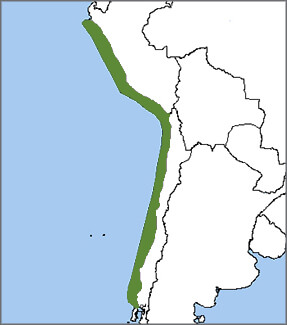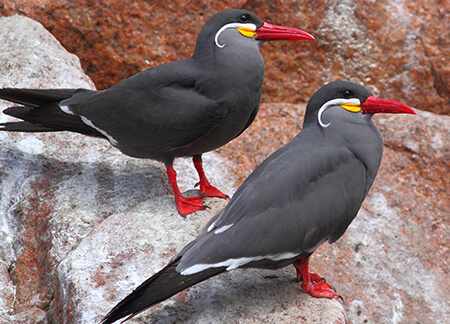 This striking bird occupies part of the same habitat ruled by the ancient Inca Empire in South America. Inca Terns are best known by their dashing white mustaches, which are found on both male and female birds.
This striking bird occupies part of the same habitat ruled by the ancient Inca Empire in South America. Inca Terns are best known by their dashing white mustaches, which are found on both male and female birds.
The species is found only near the cold waters of the Humboldt Current, where the birds feed on anchovies and other small fish. Like Least Terns, Inca Terns feed by plunge diving and surface dipping. The birds also scavenge scraps from sea lions, dolphins, and fishing boats. Declining fish stocks are one of the reasons for this species' population decline.
Nesting by the Thousands
It's a gregarious species, nesting in colonies of several thousand birds. The recording at the top of this page, from Pantanos de Villa Wildlife Refuge outside of Lima, Peru, gives an idea of what these noisy colonies are like.
The Inca Tern's elaborate courtship includes a "high flight," with the male quickly ascending to several hundred feet, pursued by the female. Pairs choose a nest site in cliff hollows or fissures—sometimes even in the old nest burrow of a Humboldt Penguin. They often return to the same nest site for several years in a row, and both parents incubate and care for the chicks.
Sign up for ABC's eNews to learn how you can help protect birds

Inca Tern pair. Photo by Greg Homel
"Coastal Peru is a spectacular place to see vast numbers of Inca Terns and other seabirds such as Peruvian Boobies and Guanay Cormorants," said ABC Vice President Mike Parr.
"It's hard to imagine that there were once even more seabirds using these waters. The double-whammy of over-fishing and excessive guano harvest—which eliminates nest sites—has been compounded by the effects of the El Niño cycle, which affects fish stocks."
From Threats to Protection
Rats, cats, and other introduced predators on some islands also affect nesting and breeding success. Islands are particularly susceptible to the effects of invasive species; for example, free-roaming cats have contributed to the extinction of 33 species on islands.
Following years of lobbying by in-country NGOs, the Peruvian government created the Guano Islands and Capes National Reserve in 2009, protecting Inca Tern as well as sea lion breeding colonies on 28 guano islands and cliffs along the coastline.
Donate to support ABC's conservation mission!



















































